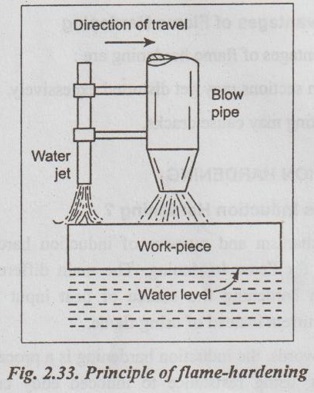Flame hardening is the process of selective hardening with a combustible gas flame as the source of heat for austenitizing.
FLAME HARDENING
1. What is Flame Hardening?
✓ Flame hardening is the process of selective hardening with a combustible gas flame as the source of heat for austenitizing.
✓ Flame hardening can be performed only on steels with a sufficiently high carbon content - at least 0.4% C (to allow hardening).
2. Principle of Flame Hardening
The surface to be hardened is heated to a temperature above its upper critical temperature, by means of a travelling oxy-acetylene torch, as shown in Fig.2.33. Then it is immediately quenched by a jet of water issuing from a supply built into the torch-assembly. Thus, the surface hardening results when the austenitized surface is quenched by the water spray that follows the flame.

3. Suitability
The flame hardening technique is suitable for the plain carbon steels with carbon contents ranging from 0.40% to 0.95% and low- alloy steels.
4. Applications
It is used to improve wear resistance and surface hardness of teeth of gears, wheels, sheaves, bushings, shafts, mill rolls, cams, spindles, hand tools, etc.
5. Advantages of Flame Hardening
The advantages of flame hardening are as follows:
1. There is practically no distortion of workpiece because only small section of steel is heated.
2. The process is more efficient and very economical for larger works.
3. As heating rate is high the surface of work remains clean.
4. It is more suitable for small quantities because it is versatile and equipment cost is less.
6. Disadvantages of Flame Hardening
The disadvantages of flame hardening are:
1. Very thin sections may get distorted excessively.
2. Overheating may cause cracks.
No comments:
Post a Comment